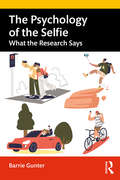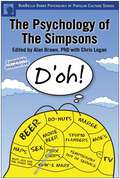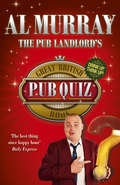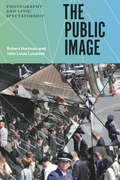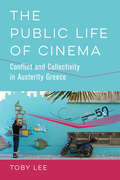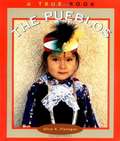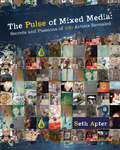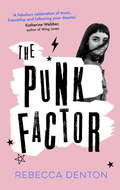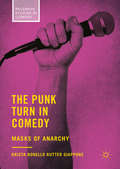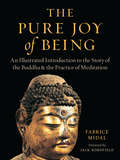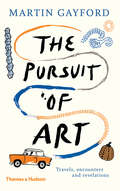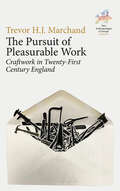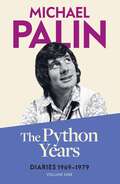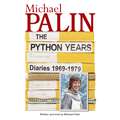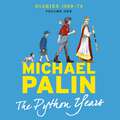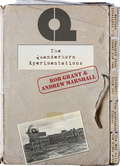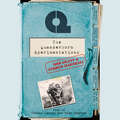- Table View
- List View
The Psychology of the Selfie: What the Research Says
by Barrie GunterThe Psychology of the Selfie provides a comprehensive overview and analysis of research on the significance of selfies, offering insights into the topic from a psychological perspective and examining important issues such as body image, self-objectification, mental health and psychological benefits. Selfies are a worldwide phenomenon. Although dismissed by critics as a sign of self-absorbed narcissism, they are also a social currency that maintains and reinforces friendships, a feedback loop for self-identity affirmation, a promotional tool for gaining social influence, and a method for preserving memories of life events. In this book, Barrie Gunter expertly explores the psychological underpinnings of the contemporary global phenomenon of "selfies", from the historical roots and meteoric rise due to technical advancements, to the different personality types of selfie-takers, to social relationships, to group and personal identity. Looking at both the psychological nature and impact of selfies, this book reviews different psychological outcomes for selfie-takers, both positive and negative, and the growth in psychological and physical problems that can sometimes arise. Presenting a comprehensive analysis specifically of selfie behaviour, this book is an essential reference for students and researchers in communications and media, journalism, information studies, psychology and sociology, as well as anyone with a general interest in the phenomenon.
The Psychology of the Simpsons: D'oh!
by Alan S. Brown Chris LoganPsychologists turn their attention to The Simpsons, one of America's most popular and beloved shows, in these essays that explore the function and dysfunctions of the show's characters. Designed to appeal to both fans of the show and students of psychology, this unique blend of science and pop culture consists of essays by professional psychologists drawn from schools and clinical practices across the country. Each essay is designed to be accessible, thoughtful, and entertaining, while providing the reader with insights into both The Simpsons and the latest in psychological thought. Every major area of psychology is covered, from clinical psychology and cognition to abnormal and evolutionary psychology, while fresh views on eclectic show topics such as gambling addiction, Pavlovian conditioning, family therapy, and lobotomies are explored.
The Pub Landlord's Great British Pub Quiz Book
by Al MurrayWho invented the pub quiz? The British, of course! Who doesn?t enjoy a rousing question-and-answer session over a pint and some scratchings? Indeed, what higher calling is there than standing in the pub loudly demanding answers to difficult questions like `d'you want some?? Here, for your pleasure, Britain?s leading pub landlord, The Pub Landlord, presents the finest collection of facts imaginable. Enjoy the attention of friends and strangers by revealing how many James Bonds there were, how many times the French have capitulated and exactly how long those pickled eggs have been in that jar on the bar. The ladies love a well-read man and this book will give you the tools needed to impress her (don?t worry, answers are included). None of your French-type philosophical musings here. No, this is a proper quiz for the Great British Public. In a public house. Or your living room.
The Pub Landlord's Great British Pub Quiz Book
by Al MurrayWho invented the pub quiz?The British, of course!Who doesn't enjoy a rousing question-and-answer session over a pint and some scratchings? Indeed, what higher calling is there than standing in the pub loudly demanding answers to difficult questions like 'd'you want some?' Here, for your pleasure, Britain's leading pub landlord, The Pub Landlord, presents the finest collection of facts imaginable. Enjoy the attention of friends and strangers by revealing how many James Bonds there were, how many times the French have capitulated and exactly how long those pickled eggs have been in that jar on the bar.The ladies love a well-read man and this book will give you the tools needed to impress her (don't worry, answers are included). None of your French-type philosophical musings here. No, this is a proper quiz for the Great British Public. In a public house. Or your living room.(P)2010 Hodder & Stoughton
The Public Image: Photography and Civic Spectatorship
by Robert Hariman John Louis LucaitesEven as the media environment has changed dramatically in recent years, one thing at least remains true: photographs are everywhere. From professional news photos to smartphone selfies, images have become part of the fabric of modern life. And that may be the problem. Even as photography bears witness, it provokes anxieties about fraudulent representation; even as it evokes compassion, it prompts anxieties about excessive exposure. Parents and pundits alike worry about the unprecedented media saturation that transforms society into an image world. And yet a great news photo can still stop us in our tracks, and the ever-expanding photographic archive documents an era of continuous change. By confronting these conflicted reactions to photography, Robert Hariman and John Louis Lucaites make the case for a fundamental shift in understanding photography and public culture. In place of suspicions about the medium’s capacity for distraction, deception, and manipulation, they suggest how it can provide resources for democratic communication and thoughtful reflection about contemporary social problems. The key to living well in the image world is to unlock photography from viewing habits that inhibit robust civic spectatorship. Through insightful interpretations of dozens of news images, The Public Image reveals how the artistry of the still image can inform, challenge, and guide reflection regarding endemic violence, environmental degradation, income inequity, and other chronic problems that will define the twenty-first century. By shifting from conventional suspicions to a renewed encounter with the image, we are challenged to see more deeply on behalf of a richer life for all, and to acknowledge our obligations as spectators who are, crucially, also citizens.
The Public Library: A Photographic Essay
by E. B. White Isaac Asimov Barbara Kingsolver Amy Tan Anne Lamott Ann Patchett Charles Simic Philip Levine Robert Dawson Theodor Seuss GeiselA &“beautifully crafted&” visual celebration with 150 photos and essays by Barbara Kingsolver, Bill Moyers, Ann Patchett, Anne Lamott, Amy Tan, and more (Publishers Weekly). Many of us have vivid recollections of childhood visits to a public library: the unmistakable musty scent, the excitement of checking out a stack of newly discovered books. Today, the more than 17,000 libraries in America also function as de facto community centers offering free access to the internet, job-hunting assistance, or a warm place to take shelter. And yet, across the country, cities large and small are closing public libraries or curtailing their hours of operation. Over eighteen years, photographer Robert Dawson crisscrossed the country documenting hundreds of these endangered institutions. The Public Library presents a wide selection of his photographs—from the majestic reading room at the New York Public Library to Allensworth, California&’s one-room Tulare County Free Library, built by former slaves. Accompanying them are essays, letters, and poetry by some of America&’s most celebrated writers. &“For book lovers, library denizens, and fans of architecture or Americana, The Public Library is a delight.&” —The Christian Science Monitor &“If you think all public libraries look pretty much the same, well, you need to take a look at this book. Oh, sure, there are plenty of grand ones, such as Philadelphia&’s own Central Library on the Parkway. But we also have the Fishtown Community Branch, featured in this volume, which used to be a firehouse and, before that, a stable. There&’s also the log cabin library in Cable, Wis. And many, many more, both grand and humble.&” —Philadelphia Inquirer &“An irrefutable argument for the preservation of public libraries . . . profound and heartbreakingly beautiful.&” —Toni Morrison
The Public Library: A Photographic Essay
by Ann Patchett Bill Moyers Robert DawsonA gorgeous visual celebration of America's public libraries including 150 photos, plus essays by Bill Moyers, Ann Patchett, Anne Lamott, Amy Tan, Barbara Kingsolver, and many more.Many of us have vivid recollections of childhood visits to a public library: the unmistakable musty scent, the excitement of checking out a stack of newly discovered books. Today, the more than 17,000 libraries in America also function as de facto community centers offering free access to the internet, job-hunting assistance, or a warm place to take shelter. And yet, across the country, cities large and small are closing public libraries or curtailing their hours of operation. Over the last eighteen years, photographer Robert Dawson has crisscrossed the country documenting hundreds of these endangered institutions. The Public Library presents a wide selection of Dawson's photographs— from the majestic reading room at the New York Public Library to Allensworth, California's one-room Tulare County Free Library built by former slaves. Accompanying Dawson's revealing photographs are essays, letters, and poetry by some of America's most celebrated writers. A foreword by Bill Moyers and an afterword by Ann Patchett bookend this important survey of a treasured American institution.
The Public Life of Cinema: Conflict and Collectivity in Austerity Greece
by Toby LeeIs culture a luxury? In this era of austerity, the value of the arts has been a topic of heated debate in Greece, where the country’s economic troubles have led to drastic cuts in public funding and much contention over the significance of cultural institutions and government-funded arts initiatives. At issue in these debates are larger questions regarding the very notions of publicness, hierarchies of value, and functions of the state that structure collective life. Beginning with the Thessaloniki International Film Festival, How to Be Public tracks this turbulence as it unfolded in the Greek film world in the early years of the crisis. Investigating the different forms of citizenship and collectivity being negotiated in cinema’s social spaces, this book considers how the arts and cultural production may illuminate the changing conditions of, and possibilities for, public and collective life in the neoliberal era.
The Pueblos (A True Book)
by Alice K. FlanaganExamines the culture, history, and society of the Pueblos.
The Pulse of Mixed Media: Secrets and Passions of 100 Artists Revealed
by Seth ApterListen closely...can you hear it? Can you hear the voices? Thoughts, insights, confessions from the creative community sharing ideas, trading secrets, venting frustrations; asking and answering questions such as, "What color rarely shows up in your work?" or "How do you express vulnerability in you art?" Or "What is one current trend that you wish would go away?" As artists, we are curious by nature and there is a longing to see inside the hearts and minds of artistic souls of our own kind. That is the beat of our lives-the Pulse of Mixed Media! In this book-a complex survey of artists around the globe-there is much for you to discover: Visual insights: Many questions are answered not only in words, but often through visual art, and include self-portraits from 31 spotlight artists such as Pam Carriker, Danny Gregory and Judy Wise. A diverse sampling of provocative questions: Over 100 artists share their thoughts on everything from color, media and tools, to emotions, secrets and self-revelations Insightful sidebar statistics: Data from thousands of participants collected through polls on the author's blog reveal a remarkable analysis of the creative community at large Indulge your inner voyeur and soak up some inspiration with The Pulse of Mixed Media today!
The Punchdrunk Encyclopaedia
by Josephine MachonThe Punchdrunk Encyclopaedia is the definitive book on the company’s work to date, marking eighteen years of Punchdrunk’s existence. It provides the first full-scale, historical account of one of the world’s foremost immersive theatre companies, drawn from unrivalled access to the collective memory and archives of their core creative team. The playful encyclopaedic format, much like a Punchdrunk masked show, invites readers to create their own journey through the ideas, aesthetics, contexts, and practices that underpin Punchdrunk’s work. Interjections from Felix Barrett, Stephen Dobbie, Maxine Doyle, Peter Higgin, Beatrice Minns, Colin Nightingale and Livi Vaughan, among others, fill out the picture with in-depth reflections. Charting Punchdrunk’s rise from the fringe to the mainstream, this encyclopaedia records the founding principles and mission of the company, documenting its evolving creative process and operational structures. It has been compiled to be useful to scholars and students from a variety of backgrounds and disciplines, from secondary level through to doctoral research, and is intended for those with a fascination for theatre in general and immersive work in particular. Ultimately it is written for those who have dared to come play with Punchdrunk across the years. It is also offered to the curious; those adventurers ready and waiting to be immersed in Punchdrunk worlds.
The Punk Factor (This Beats Perfect #3)
by Rebecca Denton'THE PUNK FACTOR is a kick ass story that will grab your heart in a fierce punk rock grip and not let go. I loved it!' Jennifer Mathieu, author of MOXIESeventeen-year-old Frankie is obsessed with what everyone else is thinking. She can keep up with the chat - from feminism to tattoos - but when it comes to her own ideas, it's not so easy to hide her lack of confidence. But there is one personal obsession she can't deny - her art student drop-out ex boyfriend Doc. With the help of her best friend, Haruna, Frankie forms a punk rock girl band to attract his attention. She's got it all sorted; the Instagram page is live, the handmade posters are everywhere, and the band even has a first gig lined up (even if they are playing to a handful of retired bingo fans). But in her efforts to make the band a success and get Doc to notice her, Frankie starts to care less about what Doc thinks and more about how much she loves making very loud music. She finally feels a glimpse of who she can be, independent of anyone else. Then one day, Doc decides he is going to win her back . . . Punk is nothing without the freedom to be exactly who you want. But what if you're not sure who that is yet? Can you make your own noise when everyone else seems so much louder than you?'Punk rock is just another word for freedom' - Patti Smith
The Punk Turn in Comedy: Masks Of Anarchy (Palgrave Studies in Comedy)
by Krista Bonello Rutter GiapponeThis book examines the interconnections between punk and alternative comedy (altcom). It explores how punk’s tendency towards humour and parody influenced the trajectory taken by altcom in the UK, and the punk strategies introduced when altcom sought self-definition against dominant established trends. The Punk Turn in Comedy considers the early promise of punk-comedy convergence in Peter Cook and Dudley Moore’s ‘Derek and Clive’, and discusses punk and altcom’s attitudes towards dominant traditions. The chapters demonstrate how punk and altcom sought a direct approach for critique, one that rejected innuendo, while embracing the ‘amateur’ in style and experimenting with audience-performer interaction. Giappone argues that altcom tended to be more consistently politicised than punk, with a renewed emphasis on responsibility. The book is a timely exploration of the ‘punk turn’ in comedy history, and will speak to scholars of both comedy and punk studies.
The Pure Joy of Being: An Illustrated Introduction to the Story of the Buddha and the Practice ofof Meditation
by Jack Kornfield Fabrice MidalAn illustrated introduction to the history of Buddhism through teachings on its relevance today and simple meditation practices.There is only one moment in time when it is essential to awaken. That moment is now. —Buddha The art of Buddhism beautifully depicts enlightened beings who demonstrate the practice of meditation yet, while deeply inspiring, art alone cannot teach one to meditate. In The Pure Joy of Being Fabrice Midal brings together traditional Buddhist art with enlightening text as a way to teach the tradition and practice of meditation. Filled with images of bodhisattvas and awakened beings who illustrate the possibility of freedom, alongside practical instruction, advice, and meditations for the everyday situations we face on a daily basis, this book is an accessible introduction to meditation and the wisdom of the Buddha’s teachings. To meditate is to remain in the present moment with attention and benevolence, to remove the desire to manage everything, and to open yourself up to life and all that is possible. It’s as simple as that. And yet, meditating is not easy. What is true happiness? How can we overcome difficulties in life with courage? Can meditation help in today’s world? The Pure Joy of Being teaches that the goal of meditation is to turn us into beings that are more human, and capable of thinking, feeling, and loving better. It offers contemporary practices to set us on this path.
The Pursuit of Art: Travels, Encounters And Revelations
by Martin GayfordOne of our leading art critics and writers, Martin Gayford, recounts his travels and meetings with the world’s greatest artists. In the course of a career thinking and writing about art, critic Martin Gayford has traveled all over the world both to see works of art and to meet artists. Gayford’s journeys, often to fairly inaccessible places, involve frustrations and complications, but also serendipitous encounters and outcomes, which he makes as much a part of the story as the final destination. In chapters that are by turns humorous, intriguing, and stimulating, Gayford takes us to places as varied as Brancusi’s Endless Column in Romania; prehistoric caves in France; the museum island of Naoshima in Japan; the Judd Foundation in Marfa, Texas; and an exhibition of Roni Horn’s work in Iceland. Interwoven with these tales are journeys to meet artists—Henri Cartier-Bresson in Paris, Marina Abramovic´ in Venice, Robert Rauschenberg in New York—and travels with artists, such as a trip to Beijing with Gilbert & George. These encounters not only provide fascinating insights into the way artists approach and think about their art, but reveal the importance of their personal environments. A perceptive, amusing, and knowledgeable companion, in The Pursuit of Art Gayford takes readers on a tour of art that is immensely entertaining, informative, and eminently readable.
The Pursuit of Pleasurable Work: Craftwork in Twenty-First Century England (New Anthropologies of Europe: Perspectives and Provocations #4)
by Trevor H. J. MarchandAgainst the backdrop of an alienating, technologizing and ever-accelerating world of material production, this book tells an intimate story: one about a community of woodworkers training at an historic institution in London’s East End during the present ‘renaissance of craftsmanship’. The animated and scholarly accounts of learning, achievement and challenges reveal the deep human desire to create with our hands, the persistent longing to find meaningful work, and the struggle to realise dreams. In its penetrating explorations of the nature of embodied skill, the book champions greater appreciation for the dexterity, ingenuity and intelligence that lie at the heart of craftwork.
The Pursuit of Pleasurable Work: Craftwork in Twenty-First Century England (New Anthropologies of Europe: Perspectives and Provocations #4)
by Trevor H. J. MarchandAgainst the backdrop of an alienating, technologizing and ever-accelerating world of material production, this book tells an intimate story: one about a community of woodworkers training at an historic institution in London’s East End during the present ‘renaissance of craftsmanship’. The animated and scholarly accounts of learning, achievement and challenges reveal the deep human desire to create with our hands, the persistent longing to find meaningful work, and the struggle to realise dreams. In its penetrating explorations of the nature of embodied skill, the book champions greater appreciation for the dexterity, ingenuity and intelligence that lie at the heart of craftwork.
The Pusan International Film Festival, South Korean Cinema and Globalization
by Soojeong AhnThis book provides a political and cultural exploration of the Pusan International Film Festival in South Korea since its inception in 1996. By paying a particular attention to the organizers' use of an Asian regionalization strategy, SooJeong Ahn reveals how the festival staked out a unique and influential position within a rapidly changing global landscape. Very little primary empirical research has been conducted to date on non-Western film festivals, though PIFF and Tokyo and Hong Kong have swiftly grown more exciting and influential as testing grounds for global cinema innovations. The initiation, development and growth of PIFF should be understood as resulting from productive tensions in the festival's efforts to serve local, regional and national constituencies. The book also reflects the complexities of rapid transformation in the South Korean film industry as it has reached out to the global market since the late 1990s. SooJeong Ahn worked for the Pusan International Film Festival between 1998 and 2002 and has completed a Ph. D. on film festivals at the University of Nottingham. Her recent publications include "Re-imagining the Past: Programming South Korean Retrospectives at PIFF," in Film International (Vol. 6, 2008), "Placing South Korean Cinema into Pusan International Film Festival: Programming Strategy in the Global/Local Context," in What a Difference a Region Makes: Cultural Studies and Cultural Industries in North-East Asia (2009); "Re-mapping Asian Cinema: The Tenth Anniversary of PIFF in 2005" in Cinemas, Identities and Beyond (2010). "In only a decade, the Pusan International Film Festival has gone from its first edition to becoming not only the leading film festival in East Asia, but also one of the world's most important. SooJeong Ahn tells this exciting story for the first time in her groundbreaking book. Her detailed analysis of the reasons for PIFF's success and the direction it has taken is full of fascinating insight and pioneers a new direction in East Asian Cinema Studies. " -- Chris Berry, Goldsmiths, University of London "Ahn's work on the Pusan International Film Festival is the first and the definitive scholarly monograph appearing in English on this key film festival in the East Asian region. With hands-on knowledge and through extensive interviews, Ahn illuminates the dynamics of the national, the regional and the global. Like the great films shown at the festival, this book is not to be missed!"-- Jinhee Choi, King's College London
The Python Years: Diaries 1969-1979 Volume One
by Michael PalinMichael Palin's bestselling diaries before, during and after Monty Python.Michael Palin's diaries begin when he was newly married and struggling to make a name for himself in the world of television comedy. But Monty Python was just around the corner . . .Enjoying an unlikely cult status early on, the Pythons then proceeded to tour the USA and Canada. As their popularity grew, so Palin relates how the group went their separate ways, later to re-form for stage shows and the celebrated films THE HOLY GRAIL and LIFE OF BRIAN. Living through the three-day week and the miners strike, and all the trials of a peripatetic life are also essential ingredients of these perceptive and funny diaries.
The Python Years: Diaries 1969-1979 Volume One
by Michael PalinMichael Palin's diaries begin when he was newly married and struggling to make a name for himself in the world of television comedy. But Monty Python was just around the corner . . .Enjoying an unlikely cult status early on, the Pythons then proceeded to tour the USA and Canada. As their popularity grew, so Palin relates how the group went their separate ways, later to re-form for stage shows and the celebrated films THE HOLY GRAIL and LIFE OF BRIAN. Living through the three-day week and the miners strike, and all the trials of a peripatetic life are also essential ingredients of these perceptive and funny diaries.Read by Michael Palin(p) 2006 Orion Publishing Group
The Python Years: Diaries 1969-1979 Volume One
by Michael PalinMichael Palin's bestselling diaries before, during and after Monty Python.Michael Palin's diaries begin when he was newly married and struggling to make a name for himself in the world of television comedy. But Monty Python was just around the corner . . .Enjoying an unlikely cult status early on, the Pythons then proceeded to tour the USA and Canada. As their popularity grew, so Palin relates how the group went their separate ways, later to re-form for stage shows and the celebrated films THE HOLY GRAIL and LIFE OF BRIAN. Living through the three-day week and the miners strike, and all the trials of a peripatetic life are also essential ingredients of these perceptive and funny diaries.
The Pythons' Autobiography By The Pythons
by Terry Jones Michael Palin Eric Idle John Cleese Terry Gilliam Graham Chapman (Estate) Bob McCabeThis is the definitive, the official, the most lavish, the completely-different-to-anything-done-before Pythons' autobiography, reissued to coincide with the eagerly-anticipated live shows.Over forty years ago, a group of five Englishmen - and one wayward American - rewrote the rules of comedy. MONTY PYTHON'S FLYING CIRCUS, an unheralded, previously unseen half-hour show of sketches, hilarities, inanities and animations, first appeared on the BBC late one night in 1969. Its impact has been felt on the world ever since. From its humble beginnings, it blossomed into the most influential movement in modern comedy. THE PYTHONS' AUTOBIOGRAPHY BY THE PYTHONS is a unique look at arguably the most important comic team of the modern age, with 64 pages of photographs, many culled from the team's own personal collections, many more seen for the first time. This is the definitive word on all things Pythonesque.
The Quanderhorn Xperimentations
by Rob Grant Andrew MarshallADAPTED BACKWARDS VIA THE FUTURE FROM THE RADIO 4 SERIES BEFORE IT WAS MADE A richer, deeper, more comprehensive exploration of the Quanderhorn phenomenon. With added secrets.England, 1952.A time of peace, regeneration and hope. A Golden Age.Unfortunately, it's been 1952 for the past 65 years.Meet Professor Quanderhorn: a brilliant, maverick scientific genius with absolutely no moral compass. Assisted by a rag-tag crew - his part-insect "son" (reputedly 'a major breakthrough in Artificial Stupidity'), a recovering amnesiac, a brilliant scientist with a half-clockwork brain, and a captured Martian hostage - he'll save the world.Even if he has to destroy it in the process.With his Dangerous Giant Space Laser, Utterly Untested Matter Transfuser Booth and Fleets of Monkey-driven Lorries, he's not afraid to push the boundaries of science to their very limit.And far, far beyond ...
The Quanderhorn Xperimentations
by Rob Grant Andrew MarshallADAPTED BACKWARDS VIA THE FUTURE FROM THE RADIO 4 SERIES BEFORE IT WAS MADE A richer, deeper, more comprehensive exploration of the Quanderhorn phenomenon. With added secrets.England, 1952.A time of peace, regeneration and hope. A Golden Age.Unfortunately, it's been 1952 for the past 65 years.Meet Professor Quanderhorn: a brilliant, maverick scientific genius with absolutely no moral compass. Assisted by a rag-tag crew - his part-insect "son" (reputedly 'a major breakthrough in Artificial Stupidity'), a recovering amnesiac, a brilliant scientist with a half-clockwork brain, and a captured Martian hostage - he'll save the world.Even if he has to destroy it in the process.With his Dangerous Giant Space Laser, Utterly Untested Matter Transfuser Booth and Fleets of Monkey-driven Lorries, he's not afraid to push the boundaries of science to their very limit.And far, far beyond ...
The Quanderhorn Xperimentations
by Rob Grant Andrew MarshallEngland, 1952.Churchill is Prime Minister for the last time. Rationing is still in force. All music sounds like the BBC Radiophonic Workshop. People like living in 1952: it's familiar and reassuring, and Britain knows its place in the world.Few have noticed it's been 1952 for the past 65 years.Meet Professor Quanderhorn; a brilliant, maverick scientific genius who has absolutely no moral compass. With his Dangerous Giant Space Laser, High Rise Farm, Invisible Robot and Fleet of Monkey-driven Lorries, he's not afraid to push the boundaries of science to their very limit.Even when it's clearly insane to keep pushing.Despite the fact he's saved the world from several Martian invasions, the attacks of the Mole People, the Troglodyte Shape-shifters and the Beatniks from Under the Sea, plus countless other sinister phenomena which threatened to rend the very fabric of reality, the Government would like to close him down. Why? Because they're terrified of him. Of his reality-warping experiments, of the mysterious button on his desk which he's constantly threatening to press. Of the unearthly secret locked in his cellar. And yet they're even more terrified it might stop being 1952 and they'll be out of power.Read by Cassie Layton and Ryan Sampson(p) Orion Publishing Group 2018
